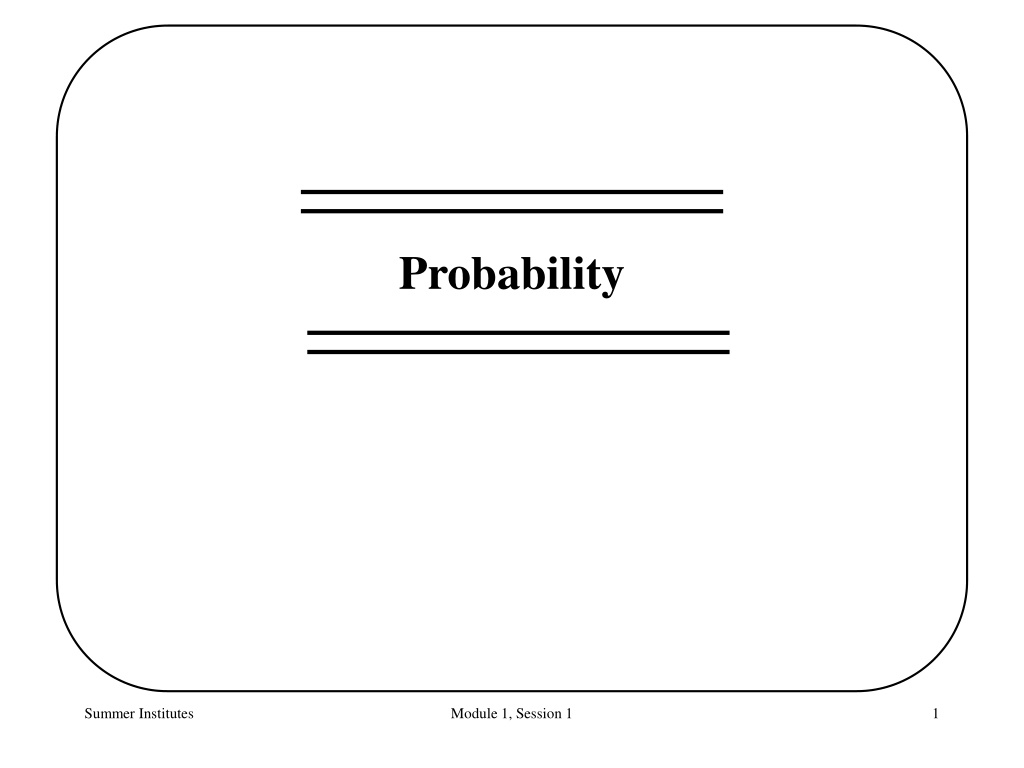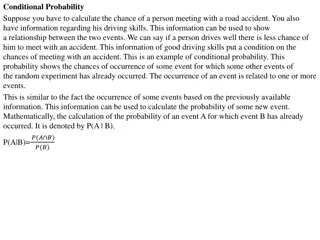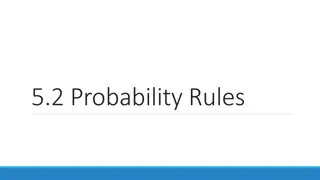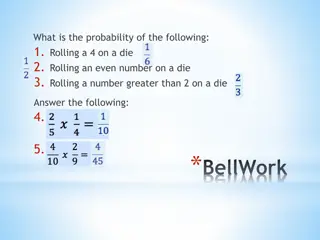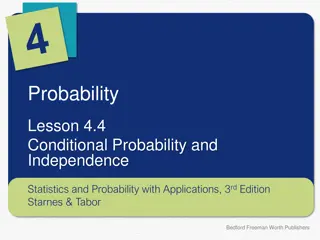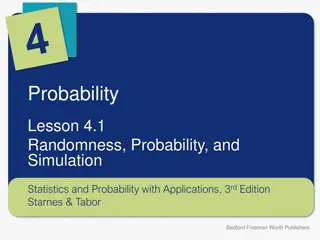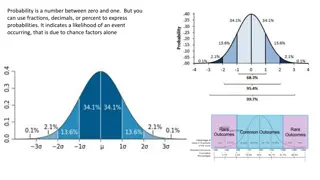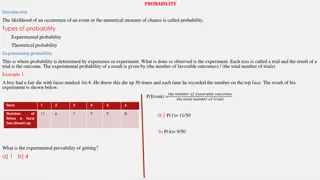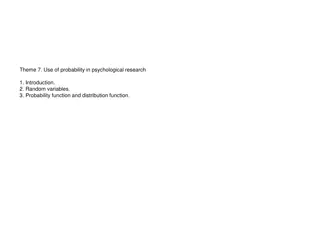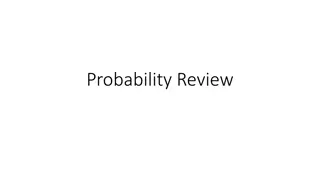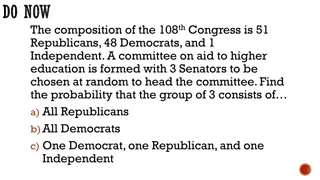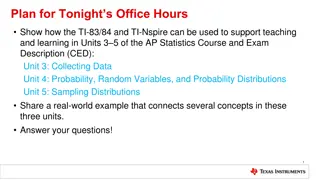Probability
Uncover the fundamentals and rules of probability including classical, relative frequency, and personal probability definitions. Delve into the basic properties, general rules, and conditional probability concepts with practical examples. Explore how to calculate probabilities, identify mutually exclusive events, and understand conditional probabilities in various scenarios. Enhance your understanding of probability theory with comprehensive explanations and visual aids.
Download Presentation

Please find below an Image/Link to download the presentation.
The content on the website is provided AS IS for your information and personal use only. It may not be sold, licensed, or shared on other websites without obtaining consent from the author.If you encounter any issues during the download, it is possible that the publisher has removed the file from their server.
You are allowed to download the files provided on this website for personal or commercial use, subject to the condition that they are used lawfully. All files are the property of their respective owners.
The content on the website is provided AS IS for your information and personal use only. It may not be sold, licensed, or shared on other websites without obtaining consent from the author.
E N D
Presentation Transcript
Probability Summer Institutes Module 1, Session 1 1
Probability Definitions: 1. Classical: P(E) = m/N If an event can occur in N mutually exclusive, equally likely ways, and if m of these possess characteristic E, then the probability of E is equal to m/N. 2. Relative Frequency: If a process or an experiment is repeated a large number of times, n, and if the characteristic, E, occurs m times, then the relative frequency, m/n, of E will be approximately equal to the probability of E. Pr(E) m/n 3. Personal Probability Summer Institutes Module 1, Session 1 2
Basic Properties of Probability 1. Two events, A and B, are said to be mutually exclusive (disjoint) if only one or the other, but not both, can occur in a particular experiment. 2. The probability of any event is non-negative and less than 1. 3. The sum of the probabilities of an exhaustive collection (i.e. at least one must occur) of mutually exclusive outcomes is 1: 4.The probability of all events other than an event A is denoted by P(Ac) [Ac stands for A complement ]. P(Ac) = 1 - P(A) P(A or B) = the probability that event A or event B (or both) occurred. P(AB) = the probability that both A and B occurred. P(A|B) = the probability of A among the subset of cases in which B is known to have occurred. Summer Institutes Module 1, Session 1 3
General Probability Rules I. Addition rule P(A or B) = P(A) + P(B) P(AB) II. Multiplication rule P(AB) = P(A|B)P(B) = P(B|A)P(A) III. Total Probability Rule If A1, An are mutually exclusive, exhaustive events, then n P(B) = P(B|Ai)P(Ai) i=1 IV. Bayes Rule P(B|A)P(A) P(A|B) = P(B|A)P(A) + P B Ac)P(Ac) Summer Institutes Module 1, Session 1 4
Summer Institutes Module 1, Session 1 5
Basic Properties of Probability 1. Suppose you toss a single die Consider the following events: E1 = roll a 1 E2 = roll an even number E3 = roll a 4, 5 or 6 E4 = roll a 3 or 5 a) What is Pr(E4)? b) Are E2 and E3 mutually exclusive? E2 and E4? c) Find a mutually exclusive, exhaustive collection of events. Do the probabilities add to 1? d) What is Pr(E4c)? Summer Institutes Module 1, Session 1 6
Conditional Probability 2. Suppose we screen 10,000 people for a disease using a new screening test. Here are the results: Test Result Pos. Neg Disease Status Pos. 9 1 10 Neg. 80 89 9910 9990 10,000 9,911 a) What is P(test positive)? b) What is P(test positive and disease positive)? c) What is P(test positive or disease positive)? d) What is P(test positive | disease positive)? e) What is P(disease positive | test positive)? Summer Institutes Module 1, Session 1 7
General Probability Rules 3. In a group of 30 symptomatic women attending a clinic, some had cervical infections with Chlamydia trachomatis (C) or Neisseria gonorrhea (G), and some were harboring both organisms and some had neither. Seven women had C only, 5 women had G only and 8 women had both (B). a) What is the probability of chlamydia (C)? b) What is the probability of gonorrhea (G)? c) What is the probability of gonorrhea (G) or chlamydia (C)? d) Are gonorrhea and chlamydia mutually exclusive? Summer Institutes Module 1, Session 1 8
General Probability Rules 4. A certain operation has a survival rate of 70%. If this operation is performed independently on three different patients, what is the probability all three operations will fail? 5. If allelle A has frequency 3/4 and allelle a has frequency 1/4 , what are the prevalances of the 3 genotypes AA, Aa and aa in the population (assuming random mating)? 6. Suppose an influenza epidemic strikes a city. In two child families the older child has influenza 10% of the time (event A), the younger child has influenza 10% of the time (event B) and both children have influenza 2% of the time . a) Are the events A and B independent? b) What is the probability that the older child has influenza if we know the younger child has influenza? Summer Institutes Module 1, Session 1 9
General Probability Rules 7. The following table gives the probability of a low birthweight (<2500g) baby for different gestational ages. What is the overall probability of having a LBW infant in this population? Length of Gestation < 20 weeks 20 27 weeks 28 36 weeks > 36 weeks Proportion born at this gestational age .0004 .0059 .0855 .9082 Prob. LBW at this gestational age .540 .813 .379 .035 Summer Institutes Module 1, Session 1 10
Bayes Rule 8. An investigator wants to determine the characteristics of a screening test for bacterial vaginosis (BV). The investigator obtains screening results on 250 women and finds 50 who screen positive and 200 who screen negative. The gold standard (i.e. true measure of disease status) is a gram stain test but this test is more expensive to do. Therefore, the investigator decides to do gram stains on all 50 women who screened positive and a random sample of 50 of the women who screened negative. The following results are obtained Gram stain + 44 3 47 - 6 Screening test + - 50 50 47 53 a. Estimate the sensitivity and specificity of the screening test. b. Estimate the positive predictive value of the screening test. (Hint: Fix the table or use Bayes rule so it mimics the results you would get if all 250 women were tested by the gold standard) Summer Institutes Module 1, Session 1 11
Extra Problems 9. The following table gives estimates of the proportion of individuals with Alzheimer s disease (AD) in various age and gender groups. Suppose an unrelated 77 year old woman, 76 year old man and 87 year old woman are selected and tested for AD. Age Group 65 69 70 74 75 79 80- 84 85+ Males 0.016 0.029 0.049 0.088 0.35 Females 0.0 0.022 0.032 0.078 0.28 a) The sample space for this experiment consists of all possible outcomes of the testing. List these (Hint: there are 8 possible outcomes). b) What is the probability all three have AD? c) What is the probability at least one has AD? d) What is the probability exactly one has AD? Summer Institutes Module 1, Session 1 12
Extra Problems 10. Randomized response surveys (RRS) are sometimes used to get unbiased responses to sensitive questions such as Have you used illegal drugs in the past 6 months? In one version of a RRS a respondent is first told to secretly flip a coin. If the coin toss is a head, the respondent is instructed to answer Yes to the sensitive question, regardless of the truth; if the coin toss is a tail, he is instructed to answer the sensitive question truthfully. This removes the stigma associated with a Yes answer since no one except the participant can tell if a Yes response is answering the sensitive question. a) Suppose the true proportion of the population who have used illegal drugs in the past 6 months is R. Write an equation that gives the proportion of the respondents expected to answer Yes to the sensitive question in terms of R (Hint: Use the total probability rule and assume that the probability of a head on the coin flip is 0.5) b) In a RRS, 60 out of 100 participants respond Yes to the question Have you used illegal drugs in the past 6 months? . Give an estimate, based on part (a), of the proportion of this population that have used illegal drugs in the past 6 months. Summer Institutes Module 1, Session 1 13
Extra Problems 11. The following table summarizes a cross-sectional study by Jerushalmy et al that sparked controversy concerning the value of various screening procedures for disease detection. No TB 1739 51 1790 TB 8 22 30 Negative X-ray Positive X-ray 1747 73 1820 a) If one of the 1820 records were randomly selected, what is the probability it would be a person with TB? b) For a randomly selected record, what is the probability that it belongs to a person who has TB and has a positive X-ray? c) If you are told that a randomly selected record is for a person with a positive X-ray, what is the probability that it belongs to a person with TB? d) What is the probability that a randomly selected record belongs to a person with TB or a person with a positive X-ray? Summer Institutes Module 1, Session 1 14
Session 1 Solutions 1) a) 2/6 b) E2,E3 no; E2, E4 yes c) E1, E2, E4 d) 4/6 2) a) 89/10000 b) 9/10000 c) 90/10000 d) 9/10 e) 9/89 3) a) 15/30 b) 13/30 c) 20/30 d) no 4) P(fail,fail,fail) = P(fail)P(fail)P(fail) = .3*.3*.3 = .027 5) P(AA) = (3/4)*(3/4)= 9/16 P(Aa) = 2*3/16 = 6/16 P(aa) = 1/16 6) a) No, since .1*.1 .02 b) P(O | Y) = P(O,Y)/P(Y) = .02/.1 = .2 7) Prob = .0004*.54 + .0059*.813 + .0855*.379 + .9082*.035 = .069 8) a) sens = 44/(44 + 3*4) spec = 47/(6 + 47*4) b) ppv = 44/50 Summer Institutes Module 1, Session 1 15
Session 1 Solutions Extra Problems 9) a) Let A = has AD; a = does not have AD 77yo 76yo 82yo Prob A A A A A a A a A A a a a A A a A a a a A a a a b) .049*.023*.078 = 8.7906e-05 c) 1 P(aaa) = 1 (1-.049)(1-.023)(1-.078) = .143 d) P(Aaa)+P(aAa)+P(aaA) = .136 10) a) Pr(Yes) = .5 + .5*R b) R = .2 11) a) 30/1820 b) 22/1820 c) 22/73 d) (30+73-22)/1820 .049*.023*.078 .049*.023*(1-.078) etc Summer Institutes Module 1, Session 1 16
